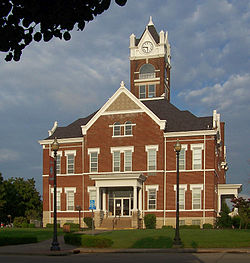Perryville, Missouri
| Perryville, Missouri | |
|---|---|
| City | |

Perry County Court House
|
|
 Location of Perryville, Missouri |
|
| Coordinates: 37°43′34″N 89°52′18″W / 37.72611°N 89.87167°WCoordinates: 37°43′34″N 89°52′18″W / 37.72611°N 89.87167°W | |
| Country | United States |
| State | Missouri |
| County | Perry |
| Township | Central |
| Incorporated | 1856 |
| Area | |
| • Total | 7.96 sq mi (20.62 km2) |
| • Land | 7.80 sq mi (20.20 km2) |
| • Water | 0.16 sq mi (0.41 km2) |
| Elevation | 581 ft (177 m) |
| Population (2010) | |
| • Total | 8,225 |
| • Estimate (2012) | 8,262 |
| • Density | 1,054.5/sq mi (407.1/km2) |
| Time zone | Central (CST) (UTC-6) |
| • Summer (DST) | CDT (UTC-5) |
| ZIP codes | 63775, 63776, 63783 |
| Area code(s) | 573 |
| FIPS code | 29-57116 |
| GNIS feature ID | 0724239 |
| Perryville has a Mayfest once a year | |
Perryville is a city in Perry County, Missouri, United States. The population was 8,225 at the 2010 census. Perryville is the county seat of Perry County.
In the 18th century the area of present-day Perryville was under French and Spanish colonial administration. The region was part of the New Bourbon district (a sub-district of the Ste. Genevieve district) of the Upper Louisiana colony, also known as the Illinois Country. Looking to expand the population, Spanish authorities agreed to allow American Catholics settle in Upper Louisiana. A Maryland Catholic and descendant of Lord Baltimore's Catholic colony, Isidore Moore, along with a number of other Maryland Catholics, who had settled in Marion, Nelson and Washington counties in Kentucky in the 1780s, looked to take up the invitation. Twenty-year-old Isidore Moore scouted both sides of the Illinois Country in 1792, at which time his visit to Kaskaskia had discouraged him, and again in 1797 when he visited St. Louis and the grasslands south of Ste. Genevieve. In 1800, Moore once again scouted the grasslands west of the Mississippi, which he found favorable. This grassland would later become known as "The Barrens" due to the open grassland with few trees.
On February 9, 1801, Isidore Moore received a concession from Spanish authorities and returned to Kentucky for his family and other families closely interrelated through marriage: the Tuckers, Haydens, Cissells, Hagans, Laytons, Brewers, and others. Some of these families had already arrived in the winter of 1803-1804 had built cabins to establish settlement rights.
...
Wikipedia
